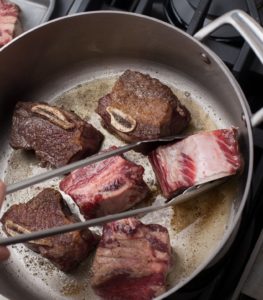As recipe writers, we come back to the same phrases over and over.
“Mix until light and fluffy…”
“…until it doubles in size…”
“Working in batches, sear the beef until it is browned all over…”
That last one seems the simplest, but it actually tends to cause the most headaches for chefs and home-cooks. Most commonly found in recipes for stews and braises, the step of browning meat often results in a burned pan and an angry smoke detector.
We brown meat before braising or stewing to create flavor. When meat is seared (so, placed in a very hot pan to brown the exterior), you’re seeing the Maillard Reaction at work. The Maillard Reaction is one of the most important concepts in all of culinary science, and it occurs when protein browns in the presence of heat. It’s often called caramelization, but that’s technically what it’s called when sugar browns in the presence of heat.
Don’t get tied up in the semantics, though, because the end-game of caramelization and Maillard browning is the same. It creates a deep, rich flavor, whether it’s the crispy crust on a well-seared steak or the umami savoriness in a pot of braised short ribs. In the case of the short ribs, though, we care as much—if not more—about the browning that occurs at the bottom of the pot as what is happening to our meat.
When recipes tell you to “scrape up the brown bits,” it’s referring to the bits of fat and protein that are a result of the meat browning in the hot pan. The brown bits are called “the fond,” and they are the first line of flavor in our braises. If they burn during the searing process, the richness we’re aiming for will end up being burnt and bitter.
So how do we avoid this? Let’s stick with the braised short ribs as an example.
To summarize a short rib (or any basic braise recipe, like chili or pot roast), you sear your meat, remove it, cook your veggies, and deglaze the pan with a liquid like wine or broth. You may add some other ingredients in between some of these steps, like tomato paste or spices, but the basic steps remain the same.
The big problem typically occurs after the browning, when we’re cooking our veggies. This is when the fond begins to burn.

If this is happening, don’t panic, and don’t switch pans! You want those brown bits, and they’re easy to save with some quick troubleshooting steps:
Step 1: Spread your veggies out over the bottom of the pan without stirring for a minute. Onions, carrots, and celery have lots of moisture, and if you let them sit and steam for a minute or so, they will work to deglaze the pan and pull up those brown bits. Sure, you were going to deglaze later, but when doesn’t really matter. Give the veggies a stir. If the fond has come up from the bottom of the pan and is no longer burning, proceed with the recipe as written. If it’s still a problem, move to Step 2.
Step 2: Pour about 1/4 cup of water or broth in the bottom of the pot and stir, scraping up the brown bits. This is enough liquid to deglaze the pan, but not so much that it will boil the veggies. Let it reduce until it’s totally dry and then keep cooking your veggies and move onto the next step. If this still isn’t enough, move onto Step 3.
Step 3: You’ve done your best, but you still have a hot spot on your pot that’s burning. At this point, you don’t want to deglaze the whole pan, because that burned spot will overpower the good flavors, so you need to target the troubled areas. Move all of your veggies over to a spot in the pot that isn’t burning and lower the heat (or turn it off completely if it’s really hot). Fold a double-layer of paper towel into a square—a few inches on all sides—and run it under a faucet until it’s wet. Grip the wet towels with a pair of tongs and use them to wipe down any burned spots in your pan. Turn the heat back up and continue with the recipe.
If you continue having trouble, consider the cookware you’re using. Most braise recipes will call for a “heavy-bottomed” pot, which can mean sturdy stainless steel, cast iron, or enameled cast iron. A flimsy pot is going to conduct heat less efficiently, and you’ll find more dramatic hot spots and quick burning.
Before we wrap it up: some people have the opposite problem, and they find it is challenging to get a nice sear on their meat at all. If your meat is not browning, you’re likely trying to cook too much at a time. Browning relies on the quick evaporation of moisture from the meat, and if a pan is crowded, that moisture can’t leave the pot, and instead it steams the meat. Wet meat can’t brown, so be sure you’re working in batches and giving your meat plenty of elbow room.
